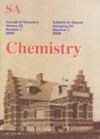Efficient Vortex-assisted Extraction of Phorbol Esters from Jatropha Leaves and Correlation Between Leaves and Seeds in Phorbol EstersContent
IF 1
4区 化学
Q4 CHEMISTRY, MULTIDISCIPLINARY
South African Journal of Chemistry-Suid-Afrikaanse Tydskrif Vir Chemie
Pub Date : 2021-01-01
DOI:10.17159/0379-4350/2021/v75a19
引用次数: 0
Abstract
ABSTRACT This work aimed to optimise and validate the vortex-assisted extraction with high-performance liquid chromatography-ultraviolet detection (HPLC-UV) method to quantify phorbol esters (PEs) in Jatropha leaves. Additionally, to evaluate the correlation between PEs content in leaves and seeds. The results of PEs content were expressed as equivalent of the major Jatropha phorbol ester, 12-deoxy-16-hydroxyphorbol-4'-[12',14'-butadienyl]-6'-[16',18',20'-nonatrienyl]-bicyclo[3.1.0]-hexane-(13-O)-2'-[carboxylate]-(16-O)-3'-]8'-butenoic-10']ate (DHPB) . One-variable-at-time strategy and 25-1V factorial fractional design were employed to determine the effects of solvent type, volume, stirring frequency, extraction time and cycles on yield. The quantification was performed using HPLC-UV. The optimum conditions were three extractions with 2% tetrahydrofuran:dichloromethane (1:1) in methanol (THF:DCM/MeOH). The sample:solvent ratio was 1 mg:25 μL, and the vortex stirring was 2200 rpm for 5 minutes. The method showed good linearity (R2 0.999), recoveries (97 to 105%), selectivity and repeatability (RSD 1.93-7.95%). In addition, good limits of detection and quantification of 2.19 and 6.65 ng μL"1, respectively, were noted. DHPB content in leaves and seeds ranged from 0.01 to 0.38 mg g"1 and 0.41 to 1.82 mg g"1, respectively. There is a statistically significant and positive linear relationship between leaves and seeds for DHPB content. These results may have practical application in analysing and predicting the amount of PEs in Jatropha leaves for environmental safety studies and the selection of better varieties for genetic improvement. Keywords: correlation, Jatropha leaves; Jatropha seeds; phorbol esters; vortex-assisted.涡旋辅助提取麻疯树叶中酚酯及叶与种子酚酯含量的相关性研究
摘要:本研究旨在优化和验证涡旋辅助提取高效液相色谱-紫外检测(HPLC-UV)定量麻疯树叶中酚酯(PEs)的方法。此外,还评估了叶片和种子中PEs含量的相关性。PEs含量的结果表示为麻风树主要酚酯,12-deoxy-16-羟基酚-4'-[12',14'-丁二烯基]-6'-[16',18',20'-非三烯基]-双环[3.1.0]-己烷-(13-O)-2'-[羧酸盐]-(16- o)-3'-]8'-丁烯酸-10'](DHPB)。采用单变量时间策略和25-1V析因分数设计,确定溶剂类型、体积、搅拌频率、提取时间和循环次数对得率的影响。HPLC-UV法定量。最佳提取条件为以2%四氢呋喃:二氯甲烷(1:1),甲醇(THF:DCM/MeOH)为溶剂进行三次提取。样品:溶剂比为1 mg:25 μL,涡旋转速为2200 rpm,搅拌5 min。方法线性良好(R2 0.999),加样回收率(97 ~ 105%),选择性和重复性(RSD 1.93 ~ 7.95%)。此外,检测限和定量限分别为2.19和6.65 ng μL"1。叶片和种子中DHPB含量分别为0.01 ~ 0.38 mg g"1和0.41 ~ 1.82 mg g"1。叶片与种子的DHPB含量呈显著正线性关系。这些结果可能在分析和预测麻疯树叶片pe含量、环境安全性研究和选择遗传改良品种方面具有实际应用价值。关键词:相关性;麻疯树叶片;麻疯树种子;佛波醇酯;vortex-assisted。
本文章由计算机程序翻译,如有差异,请以英文原文为准。
求助全文
约1分钟内获得全文
求助全文
来源期刊
CiteScore
3.10
自引率
0.00%
发文量
6
审稿时长
>12 weeks
期刊介绍:
Original work in all branches of chemistry is published in the South African Journal of Chemistry. Contributions in English may take the form of papers, short communications, or critical reviews.

 求助内容:
求助内容: 应助结果提醒方式:
应助结果提醒方式:


